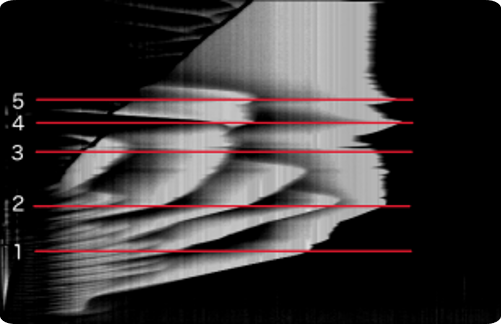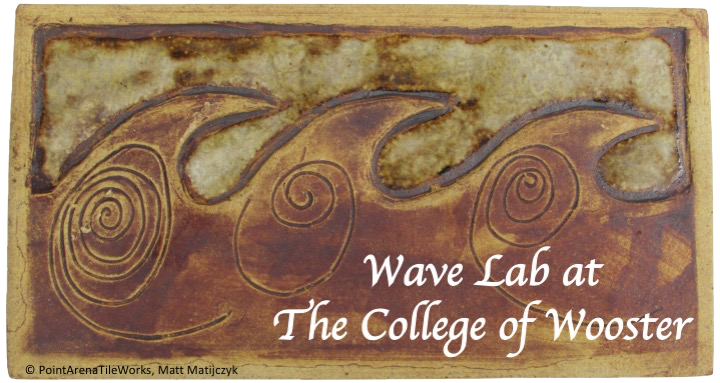Effect of fluid flow on 1D reaction-diffusion waves
Advection has a huge effect on the propagation behavior of reaction-diffusion waves when an external force introduces flow in a system (E.g., Andresén et al., Stationary space-periodic structures with equal diffusion coefficients, Phys. Rev. E, 60(1), 297-301 (1999); Kærn and Menzinger, Flow-distributed oscillations: Stationary chemical waves in a reacting flow, Phys. Rev. E, 60(4), R3471, 1999; Kærn and Menzinger, Experiments on Flow-Distributed Oscillations in the Belousov-Zhabotinsky Reaction, J. Phys. Chem. A, 106(19), 4897-4903, 2002). We use the excitable Belousov-Zhabotinsky reaction, to investigate the effect of advection on reaction-diffusion (RD) waves in quasi-1D systems (glass capillary tubes with inner diameter below 0.6 mm). Because RD waves propagate in a medium without actual mass transport of the medium itself, it is possible to create a ‘standing wave’ if the flow of the BZ medium is opposite to the wave’s propagation direction (a propagating wave not moving in space for the outside viewer, similar like a person moving at the same speed as a slow train but in the opposite direction). The effect of advection by Poiseuille flow on the propagation velocity has been investigated numerically in, for example, Edwards, Propagation velocities of chemical reaction fronts advected by Poiseuille flow, Chaos, 16(4), 043106, 2006.

Mitch Gavin ’16 built a setup using a piston pump. The figure, created by Chase Fuller ’19, gives an example of a time-space plot with a wave moving to the right and fluid flow to the left (1D gray-value cut of the center of a capillary with subsequent images at Δt in y-direction). Initially, the BZ medium in the capillary is at rest and the wave propagates with its normal speed to the right. Between t = 600 s and t = 1000 s, the changing fluid flow rates result in significant wave speed changes and a ‘nearly stationary wave’.
After changing to a peristaltic pump to overcome the volume limitations of a syringe pump, we continue our search for a real ‘standing wave’. We also plan to explore the behavior of advection parallel to the wave’s propagation direction and create a better systems with more than one observable channel at the time.
Senior Independent Study theses
- Aidan Mason ’24: Fabricating a Flow Chemistry System to Investigate Reaction-Diffusion Waves in Advected Belousov-Zhabotinsky Systems
- William Hilbert ’22: Designing an Apparatus for Creating 1D Standing Waves Using Reaction-Diffusion-Advection Systems
- Jack Mershon ’18: Modified propagation of anomalous Belousov-Zhabotinsky waves in a quasi-1D system
- Mitch Gavin ’16: An injector to investigate reaction-diffusion-advection systems
NSF-REU Summer research
- Aidan Mason ’24 (2023): Effects of Laminar Flow on the Belousov-Zhabotinsky Reaction
- Josh Ballard-Myer – Georgia College & State University, Milledgeville, GA (2018): Analysis of an Experimental Setup for BZ Waves in a Quasi 1-D RDA System
- Chase Fuller (2017): Effects of advection on the Belousov-Zhabotinsky reaction: standing excitation waves in a quasi-1D system
- Jersson Pachar – Wittenberg University, Springfield, OH (2016): Effects of Advection on Reaction-Diffusion Waves
Oral presentations
- Jack Mershon: “Modified Propagation of Belousov-Zhabotinsky Waves in a Quasi-1D System“, Spring 2018 Meeting of the APS Ohio-Region Section, East Lansing, MI, 2018 March 23-24
Poster presentations
- C. Fuller, J. Mershon, and N. Manz: “Effects of Fluid Flow on Chemical Excitation Waves with Anomalous Dispersion Relations” APS March Meeting 2018, Los Angeles, CA, USA, 2018 March 7
- C. Fuller and N. Manz: “Effects of advection on the Belousov-Zhabotinsky reaction: standing excitation waves in a quasi-1D system” Fall 2017 Meeting of the APS Ohio-Region Section, Oxford, OH, 2017 October 13-14
- J. Pachar and N. Manz: “Effects of Advection on Reaction-Diffusion Waves” Fall 2016 Meeting of the APS Ohio-Region Section, Bowling Green, OH, USA, 2016 October 7-8
